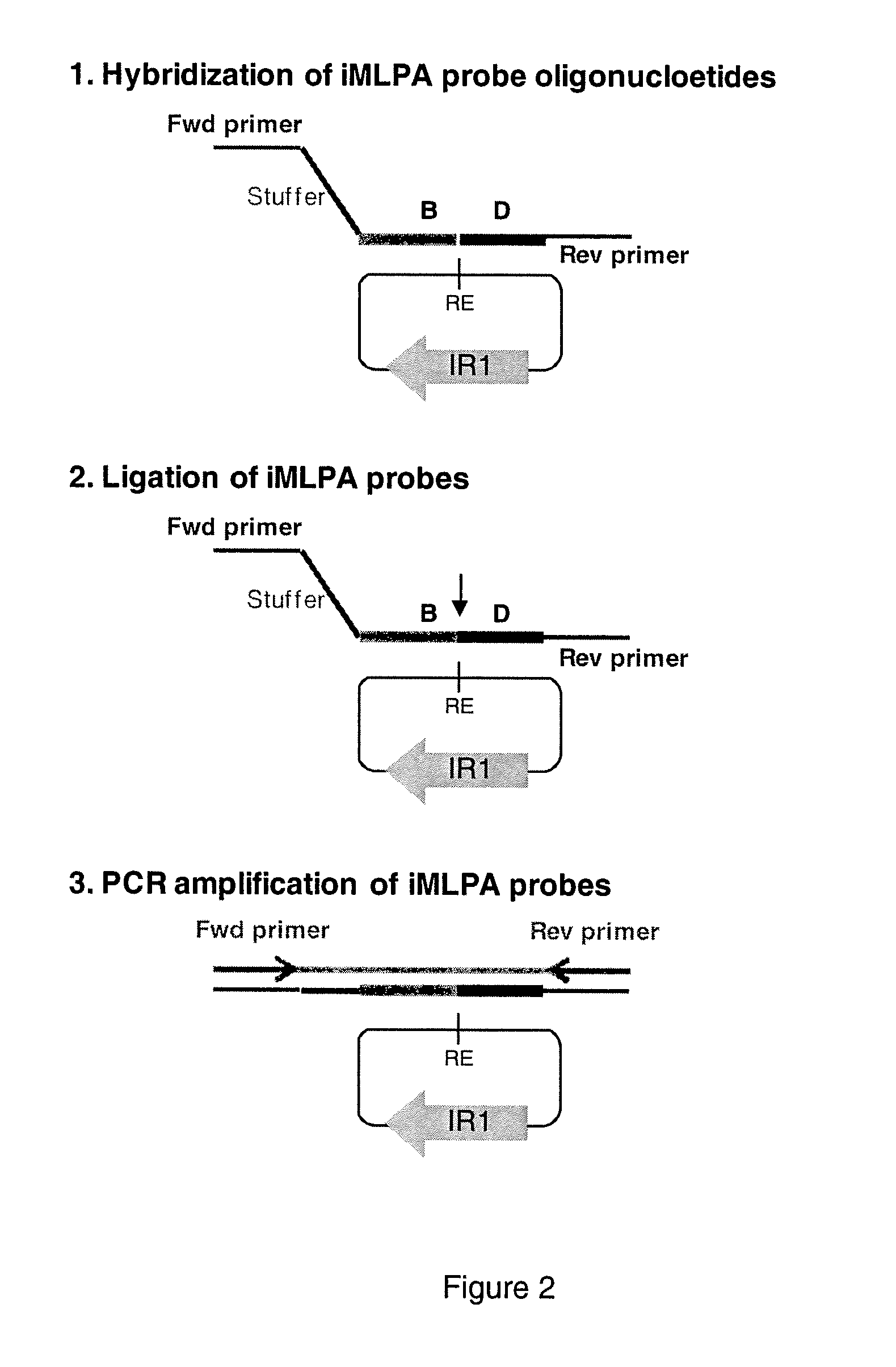INVERSE MULTIPLEX LIGATION-DEPENDENT PROBE AMPLIFICATION (iMLPA), AN IN VITRO METHOD OF GENOTYPING MULTIPLE INVERSIONS
a technology of multiple inversions and probe amplification, applied in the field of biomedicine, can solve the problems of limited pcr, no method serves to study multiple inversions in a large number of individuals, and inversions have been very little studied in humans
- Summary
- Abstract
- Description
- Claims
- Application Information
AI Technical Summary
Benefits of technology
Problems solved by technology
Method used
Image
Examples
example 1
Digestion of DNA with Restriction Enzymes
[0088]For the preparation of the samples for iMLPA, first we selected a concentration of genomic DNA between 300-800 ng of each individual. In the present example, 400 ng of genomic DNA of each individual are digested overnight at 37° C. under conditions recommended by the manufacturer in a 20 μl reaction with 5 U of the appropriate restriction enzyme. In our case we used the restriction enzymes EcoRI, HindIII, SacI, BamHI from Roche and NsiI and BglII from New England Biolabs. The restriction enzymes are then inactivated at 65° C. for 15 minutes, with the exception of BglII that is inactivated at 85° C. for 20 minutes.
example 2
Self-Ligation of the Digested Fragments
[0089]In the second step, circularization by self-ligation of the DNA fragments is performed for 16 hours at 16° C. in an incubator by mixing the 20 μl of the digestion reaction of each enzyme (totaling 120 μl) in a total volume of 640 μl with 400 U of T4 DNA Ligase (New England Biolabs), 64 μl of the ligation buffer provided by the manufacturer, and 455 μl of water. This results in a concentration of the DNA fragments generated by each enzyme of 0.625 ng / μl, which is optimal for self-ligation and subsequent processes. Next, in one step, the ligation is inactivated and the DNA is broken at 95° C. for 5 min in order to make its recovery easier. Finally the DNA is put in ice for at least 5 minutes.
example 3
[0090]The DNA recovery is carried out using the kit ZR-96 DNA Clean & Concentrator™-5 (Zymo Research) according to the instructions provided by manufacturer. Briefly, two volumes (1280 μl) of DNA Binding Buffer are added to the ligation volume, vortexed for 30 sec, and left at least 5 min at room temperature. The mixture is then loaded into a Zymo-Spin™ I-96 Plate and centrifuged. Next, 300 μl of DNA Wash Buffer were added to each well and centrifuged, and the washing step is repeated two times. DNA from each sample is finally resuspended by adding 12 μl of water, obtaining at the end approximately 7.5 μl of recovered DNA.
PUM
| Property | Measurement | Unit |
|---|---|---|
| Digital information | aaaaa | aaaaa |
| Length | aaaaa | aaaaa |
Abstract
Description
Claims
Application Information
 Login to View More
Login to View More - R&D
- Intellectual Property
- Life Sciences
- Materials
- Tech Scout
- Unparalleled Data Quality
- Higher Quality Content
- 60% Fewer Hallucinations
Browse by: Latest US Patents, China's latest patents, Technical Efficacy Thesaurus, Application Domain, Technology Topic, Popular Technical Reports.
© 2025 PatSnap. All rights reserved.Legal|Privacy policy|Modern Slavery Act Transparency Statement|Sitemap|About US| Contact US: help@patsnap.com


